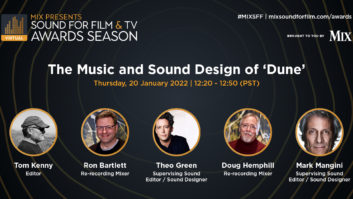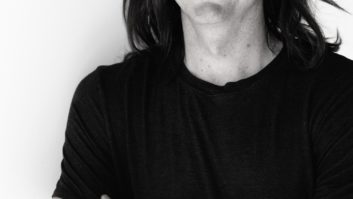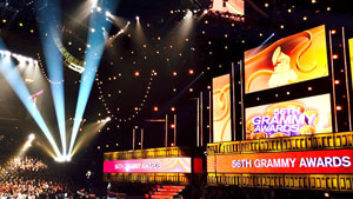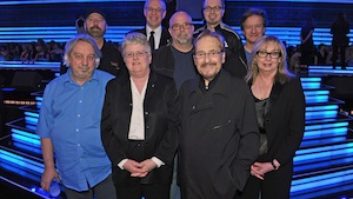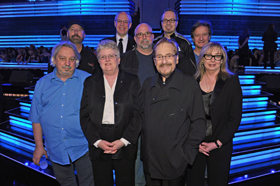
The core Grammy Audio team, with some friends from Springsteen’s camp: Back row, left to right: Hank Neuberger, Glenn Lorbecki. Middle row: Toby Scott, John Harris, Bob Clearmountain. Bottom row: Eric Schilling, Leslie Ann Jones, Phil Ramone, Maureen Droney.
Photo courtesy of The Recording Academy/Wireimage.com © 2012
There isn’t a show on television that devotes more attention and resources to quality sound than the Grammy Awards, and this year, amid changes in programming and unplanned guests, the audio team again delivered stellar 5.1 audio from Staples Center on February 12. It’s not that other shows don’t care, or don’t do quality work; it’s just that nobody does it better. And the care and attention permeates the production, from house sound to wireless setup/monitoring, to the Music Mix Mobile broadcast music mix, to the 5.1/stereo/mono broadcast feed out of the Denali truck and back to CBS New York for transmission in Dolby 5.1, to the monitoring of cable and broadcast signals from around the country, in real time during the live show.

Fletch of ATK/Audiotek leans over the SD7 to consult with FOH mixer Ron Reaves at Staples Center; to their right is Mikael Stewart, production mixer, at an SD10
Photo courtesy of The Recording Academy/Wireimage.com © 2012
Much of the success—and the Emmy nominations and wins that have rolled in—can be attributed to the highly professional crew that has remained intact over the many years and functions as a well-oiled technical and creative unit. It begins with the Recording Academy’s Television Committee and their representatives on site, who monitor the house sound and broadcast: Phil Ramone in the Denali production truck; Leslie Ann Jones at Front of House; and Hank Neuberger overseeing the overall music for broadcast.

Broadcast music mixer John Harris at the Avid console in the Music Mix Mobile truck.
Photos courtesy of The Recording Academy/Wireimage.com © 2012
Then there is Audio Supervisor Mike Abbott, who coordinates all things audio, from working with ATK Audiotek on the house system to feeding the music and production trucks. Music Mix Mobile, with EIC Joel Singer and veteran mixers John Harris and Eric Schilling, run two Avid D-Control/Genelec-based vehicles connected/networked via MADI. Dave Bellamy is on wireless, incorporating Shure, Audio-Technica and Sennheiser systems. And Ron Reaves is FOH music mixer, with Mikael Stewart on production and inserts, all supported by Fletch and the crew at ATK Audiotek. Tom Pesa and Michael Parker mixed monitors.
Not much changed in the broadcast chain this year. Music Mix Mobile starts rehearsals on Thursday, getting individual mixes for artists during their 1.5-hour sessions, then switching to the other truck for remixing with the artist to “get it right” for broadcast. Harris and Schilling leapfrog each other, truck to truck, on each artist.
The big news this year was the change in the house system. After years of working on Yamaha PM1Ds, the team decided to make a switch for 2012 as Yamaha had announced its discontinuation of the unit in 2009. This year, after much testing, they settled on an all-DiGiCo system—SD7 for Reaves at front of house, because he “needed all those inputs”; SD10 for Stewart at production; and two SD10s for each of the two monitor positions (there are two stages to facilitate rapid changeovers). Each stage had two 56 I/O stage boxes running at 48k (with hints at 96k for next year!), and there were 488 total channels available on the Fiber-based Opticore system; all I/O could be shared console to console. Taidus Vallandi supplied and babysat the system through distributor Group One. “We have one A/D at the pre and one D/A at the amp,” he says. “And it is the only true redundant digital system out there, so it’s fail-safe. Each console is really two consoles, mirrored inside the desk.” The P.A. was a JBL Vertec system, fed by Powersoft amps.
“The Yamaha boards had worked very well for us all these years, but we knew it was time for a change, and we decided to go for it this year,” Reaves explains. “DiGiCo sent an SD7 to my house 30 days in advance so I could get comfortable with it, and their level of support has been just phenomenal. With all respect to Yamaha, those boards were 10 years old, so this was like going from a Volkswagen to a Ferrari. I got to highpass filter across the strings, I reached for 4k on the vocal—things I wouldn’t have done before. And it just sounds great.”
